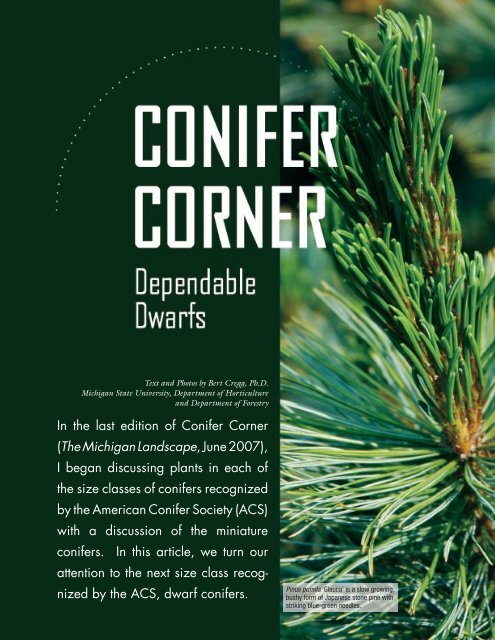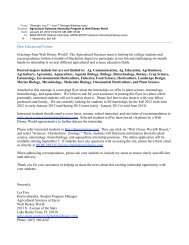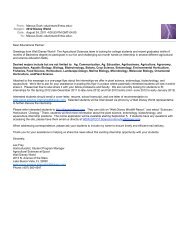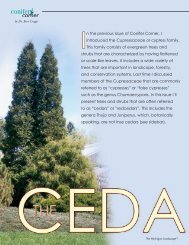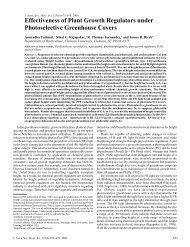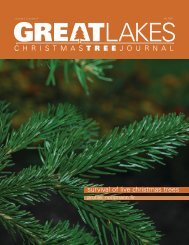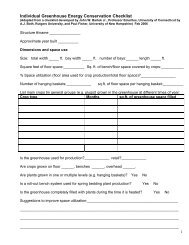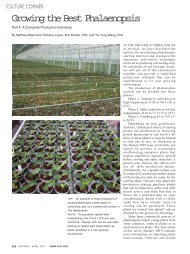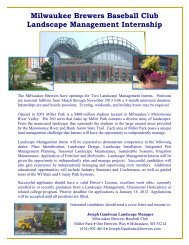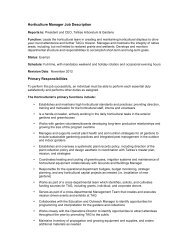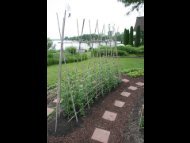Dwarf conifers - Department of Horticulture - Michigan State University
Dwarf conifers - Department of Horticulture - Michigan State University
Dwarf conifers - Department of Horticulture - Michigan State University
Create successful ePaper yourself
Turn your PDF publications into a flip-book with our unique Google optimized e-Paper software.
Text and Photos by Bert Cregg, Ph.D.<br />
<strong>Michigan</strong> <strong>State</strong> <strong>University</strong>, <strong>Department</strong> <strong>of</strong> <strong>Horticulture</strong><br />
and <strong>Department</strong> <strong>of</strong> Forestry<br />
In the last edition <strong>of</strong> Conifer Corner<br />
(The <strong>Michigan</strong> Landscape, June 2007),<br />
I began discussing plants in each <strong>of</strong><br />
the size classes <strong>of</strong> <strong>conifers</strong> recognized<br />
by the American Conifer Society (ACS)<br />
with a discussion <strong>of</strong> the miniature<br />
<strong>conifers</strong>. In this article, we turn our<br />
attention to the next size class recognized<br />
by the ACS, dwarf <strong>conifers</strong>.<br />
Pinus pumila ‘Glauca’ is a slow growing,<br />
bushy form <strong>of</strong> Japanese stone pine with<br />
striking blue-green needles.<br />
August 2007<br />
29
Bird’s nest spruce (Picea abies ‘Nidiformis’) is a reliable performer and an alternative to<br />
other foundation plants.<br />
Curious yellow. This<br />
Chamaecyparis obtusa<br />
‘Nana Lutea’ is a dramatic<br />
specimen plant.<br />
Photo: Hannah Cregg<br />
This dwarf eastern<br />
white pine at the<br />
Morton arboretum is<br />
over 20 feet tall and<br />
shows the dramatic<br />
character <strong>of</strong> mature<br />
dwarf <strong>conifers</strong>.<br />
Based on the ACS classification, dwarf <strong>conifers</strong><br />
grow one to six inches per year and reach one<br />
to six feet by age ten. Their slow growth rate<br />
combined with a variety <strong>of</strong> growth habits and<br />
colors make dwarf <strong>conifers</strong> a great choice for a<br />
wide range <strong>of</strong> landscape uses. <strong>Dwarf</strong> <strong>conifers</strong>, like<br />
the miniature <strong>conifers</strong> we discussed in the June<br />
issue, are outstanding accent or specimen plants<br />
that add unique character to the landscape. <strong>Dwarf</strong><br />
<strong>conifers</strong> can be especially effective in combination<br />
with perennials or ornamental grasses. They are also<br />
great additions to rock gardens or other specialty<br />
gardens.<br />
Aging gracefully<br />
<strong>Dwarf</strong> <strong>conifers</strong> grow slowly, but they do grow.<br />
Many dwarf <strong>conifers</strong> can reach 12 or 15 feet<br />
after thirty or forty years in the landscape. As<br />
they grow, dwarf <strong>conifers</strong> <strong>of</strong>ten take on a unique<br />
character that is difficult to duplicate. At the<br />
Harper Collection <strong>of</strong> <strong>Dwarf</strong> and Unusual Conifers<br />
at Hidden Lake Gardens in Tipton, <strong>Michigan</strong>,<br />
many <strong>of</strong> the specimens are 30-plus years old and<br />
are taking on distinctive personalities. In addition<br />
to the Harper Collection, conifer connoisseurs<br />
can see dwarf <strong>conifers</strong> with character born <strong>of</strong><br />
age at the Morton Arboretum in Lisle, Illinois<br />
and in the Gotelli Collection <strong>of</strong> <strong>Dwarf</strong> and<br />
Slow-growing Conifers at the United <strong>State</strong>s<br />
National Arboretum in Washington, D.C.<br />
Alternatives for yews and junipers<br />
<strong>Dwarf</strong> <strong>conifers</strong> can also provide an interesting<br />
and appealing alternative for yews and junipers as<br />
foundation plants. While the term ‘dwarf <strong>conifers</strong>’<br />
usually conjures up an image <strong>of</strong> cone-shaped<br />
mini-Christmas trees, many dwarf <strong>conifers</strong> have<br />
irregular or spreading growth habits and can be<br />
used as a substitute for yew or juniper hedges.<br />
When thinking <strong>of</strong> dwarf <strong>conifers</strong> as specimen,<br />
foundation or accent plants, here are some <strong>conifers</strong><br />
to consider:<br />
30 The <strong>Michigan</strong> Landscape
Picea abies ‘Nidifomis’<br />
Irregular, spreading spruce with dense,<br />
horizontal layers <strong>of</strong> branches, much wider<br />
than tall. Light green color. Zone 2, grows<br />
3-6" per year. Bird’s nest spruce is a prime<br />
example <strong>of</strong> a dwarf conifer that can be used<br />
as a foundation plant. Conifer expert Chub<br />
Harper notes: “This is an iron-clad plant.<br />
We used a ‘Nidiformis’ to replace my<br />
neighbor’s raunchy juniper.”<br />
Chamaecyparis obtusa ‘Nana Lutea’<br />
A dwarf form <strong>of</strong> Hinoki Falsecypress with<br />
bright yellow foliage. The yellow color is a<br />
blend <strong>of</strong> golden yellow foliage and white<br />
foliage, the white <strong>of</strong>ten being a band interior<br />
to the golden yellow. If the plant is put into<br />
the shade the golden yellow foliage tends<br />
toward lime-green. Grows at about the same<br />
rate as its green counterpart, Chamaecyparis<br />
obtusa ‘Nana Gracilis’, at about 4" to 6" per<br />
year.<br />
Abies koreana ‘Prostrata’<br />
A reliable plant. Specimen at Hidden Lake<br />
Gardens is 35 years old. Needles are blue on<br />
the underside. Like most Korean firs, expect<br />
lots <strong>of</strong> colorful cones.<br />
Picea omorika ‘Nana’<br />
Serbian spruces are always a great choice for<br />
those suffering from ‘blue spruce burnout’.<br />
Serbian’s can’t match Picea pungens for<br />
color, but they are adaptable to a wide<br />
range <strong>of</strong> sites and have fewer pest problems<br />
than their blue-blood cousins. More upright<br />
than spreading.<br />
Picea pungens ‘Montgomery’<br />
For those that still need a blue spruce fix<br />
and are short on space, here’s your plant.<br />
Globe-shaped when young, Montgomery is<br />
<strong>of</strong>ten grafted high on a standard for the<br />
‘lollipop-on-a-stick’ effect. Becomes broadly<br />
pyramidal with age. Bright blue color is a<br />
real show-stopper. Chub notes: “This one’s<br />
going to take over the world.”<br />
Compact <strong>Dwarf</strong> Korean fir (Abies koreana ‘Compact <strong>Dwarf</strong>’) has a broad, compact growth<br />
habit. Its short needles add texture to the landscape.<br />
Tried and true. Picea abies ‘Parviformis’ (left) and P. pungens ‘Montgomery’ (right) have held<br />
up well over the years in the Harper Collection at Hidden Lake Gardens.<br />
Serbian spruces<br />
are reliable plants<br />
and this dwarf<br />
form (P. omorika<br />
‘Nana’) is no<br />
exception.<br />
August 2007<br />
31
Not just baby Christmas trees… <strong>Dwarf</strong> <strong>conifers</strong> come in a variety <strong>of</strong> forms like this Pygmy<br />
spruce (Picea abies ‘Pygmaea’) near the entrance to the Harper Conifer Collection.<br />
Thuja plicata ‘Grune<br />
Kugel’ has a rounded<br />
form that holds up<br />
better to snow than<br />
some globe <strong>conifers</strong>.<br />
Photo: Dax Herbst.<br />
‘Sanders Blue’ white spruce (Picea glauca ‘Sander’s Blue’) does a blue twist on the usual<br />
dwarf Alberta spruce.<br />
Picea abies ‘Pygmaea’<br />
Irregular and <strong>of</strong>ten variable in form. Usually<br />
listed as globose, this Norway spruce can be<br />
somewhat conical or even spreading. Bright<br />
green color.<br />
Thuja plicata ‘Grune Kugel’<br />
This cultivar <strong>of</strong> western redcedar may make<br />
a good alternative to Golden Globe<br />
arborvitae. A dwarf, globose selection with<br />
dark green shiny foliage. The tips have a<br />
very nice bronze to purple tint in the winter<br />
months in Zone 5. Appears to resist heavy<br />
snow loads and maintains an erect upright<br />
form without damage.<br />
Picea glauca ‘Sander’s Blue’<br />
The variation on <strong>Dwarf</strong> Alberta spruce<br />
(Picea glauca ‘Conica’) is a real eye-catcher.<br />
Tight, upright conical plant forms a mosaic<br />
<strong>of</strong> blue and green. It usually starts out very<br />
blue when young and juvenile and starts<br />
turning green as it gets older. On older<br />
plants it produces a nice tapestry effect<br />
between the blue and green needles. A<br />
classic case <strong>of</strong> photos not doing a plant<br />
justice.<br />
Dr. Bert Cregg is an Associate Pr<strong>of</strong>essor in the<br />
<strong>Department</strong>s <strong>of</strong> <strong>Horticulture</strong> and Forestry at MSU.<br />
32 The <strong>Michigan</strong> Landscape
Chub’s Choices<br />
Chub Harper lists his ‘top five’ favorite plants in each <strong>of</strong> the ACS conifer<br />
size classes.<br />
DWARF CONIFERS — Growth per year: one to six inches.<br />
Size at ten years: one to six feet.<br />
1. Abies lasiocarpa ‘Green Globe’ <strong>Dwarf</strong> Rocky Mountain fir<br />
2. Picea abies ‘Nidiformis’ Bird’s Nest Norway spruce<br />
3. Picea glauca ‘Conica’ <strong>Dwarf</strong> Alberta spruce<br />
See me… Feel me... (with apologies to The Who). According to<br />
Chub Harper, everyone that sees this ‘Green Globe’ alpine fir<br />
(Abies lasiocarpa ‘Green Globe’) has to touch it.<br />
4. Picea omorika ‘Nana’ <strong>Dwarf</strong> Serbian spruce<br />
5. Picea pungens ‘Montgomery’ Montgomery Colorado spruce<br />
<strong>Dwarf</strong> <strong>conifers</strong>, such as ‘Sander’s Blue’ white<br />
spruce (left) and ‘Rainbow’s End’ white spruce<br />
(right), are great accent plants.<br />
Ornamental conifer size classes recognized by the<br />
American Conifer Society<br />
Category Growth per year 1 Approx. size at 10 years 2<br />
Miniature < 1" < 1'<br />
<strong>Dwarf</strong> 1" to 6" 1' to 6'<br />
Intermediate 6" to 12" >6' to 15'<br />
Large >12" >15'<br />
1<br />
Size may vary due to cultural, climatic and geographical region<br />
2<br />
Refers to growth in any direction<br />
August 2007<br />
Source: American Conifer Society (www.<strong>conifers</strong>ociety.org)<br />
33


